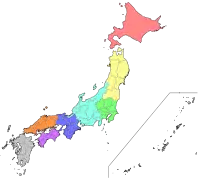List of regions of Japan
Japan is divided into eight regions. They are not official administrative units, though they have been used by government officials for statistical and other purposes since 1905. They are widely used in, for example, maps, geography textbooks, and weather reports, and many businesses and institutions use their home regions in their names, for example Kinki Nippon Railway, Chūgoku Bank, and Tōhoku University.
| Administrative divisions of Japan |
|---|
| Prefectural |
| Prefectures |
| Sub-prefectural |
| Municipal |
| Sub-municipal |
Each region groups several of the country's 47 prefectures, except for the region of Hokkaidō, which is the same as Hokkaidō Prefecture. Of the other three main islands of Japan, Shikoku make up one region, Kyūshū is generally combined with Okinawa Prefecture as Kyūshū Region, and the largest island, Honshū is divided into five regions.
Japan has eight High Courts, but their jurisdictions do not correspond to the eight regions (see Judicial system of Japan for details).
Table
| Region | Population | Area in km²[1] | Prefectures contained |
|---|---|---|---|
| Hokkaidō | 5.4 million[2] | 83,000 | Hokkaidō |
| Tōhoku | 8.91 million[3] | 67,000 | Akita, Aomori, Fukushima, Iwate, Miyagi, Yamagata |
| Kantō | 43.3 million[4] | 32,000 | Chiba, Gunma, Ibaraki, Kanagawa, Saitama, Tochigi, Tōkyō |
| Chūbu | 21.4 million[5] | 67,000 | Aichi, Fukui, Gifu, Ishikawa, Nagano, Niigata, Shizuoka, Toyama, Yamanashi |
| Kansai (also known as Kinki) | 22.5 million[6] | 33,000 | Hyōgo, Kyōto, Mie, Nara, Ōsaka, Shiga, Wakayama |
| Chūgoku | 7.3 million[7] | 32,000 | Hiroshima, Okayama, Shimane, Tottori, Yamaguchi |
| Shikoku | 3.8 million[8] | 19,000 | Ehime, Kagawa, Kōchi, Tokushima |
| Kyūshū | 14.5 million[9] | 44,000 | Fukuoka, Kagoshima, Kumamoto, Miyazaki, Nagasaki, Ōita, Okinawa, Saga |
Regions and islands
This is a list of Japan's major islands, traditional regions, and subregions, going from northeast to southwest.[10][11] The eight traditional regions are marked in bold.
- Hokkaidō (the island and its archipelago)
- Honshū
- Tōhoku region (northern part)
- Kantō region (eastern part)
- Nanpō Islands (part of Tokyo Metropolis)
- Chūbu region (central part)
- Hokuriku region (northwestern Chūbu)
- Kōshin'etsu region (northeastern Chūbu)
- Tōkai region (southern Chūbu)
- Kansai (or Kinki) region (west-central part)
- Chūgoku region (western part)
- San'in region (northern Chūgoku)
- San'yō region (southern Chūgoku)
- Shikoku
- Kyūshū
References
- Japan's Regional Megamarkets - Semantic Scholar (PDF)
- What special characteristics does Hokkaido have? from Kids Web Japan
- What special characteristics does the Tohoku region have? from Kids Web Japan
- What special characteristics does the Kanto region have? from Kids Web Japan
- What special characteristics does the Chubu region have? from Kids Web Japan
- What special characteristics does the Kinki region have? from Kids Web Japan
- What special characteristics does the Chugoku region have? from Kids Web Japan
- What special characteristics does the Shikoku region have? from Kids Web Japan
- What special characteristics does the Kyushu-Okinawa region have? from Kids Web Japan
- Regions of Japan on japan-guide.com
- Regions of Japan on web-japan.org
External links
![]() Media related to Regions of Japan at Wikimedia Commons
Media related to Regions of Japan at Wikimedia Commons


